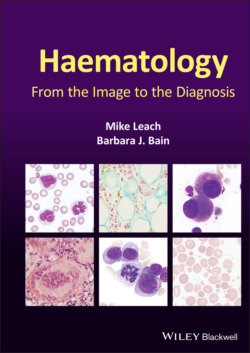Читать книгу Haematology - Barbara J. Bain, Irene Roberts - Страница 15
Оглавление6 Sarcoidosis
A 50‐year‐old man was referred for investigation of low‐volume lymphadenopathy and mild splenomegaly noted on a CT scan performed as part of the investigation of loin pain. Renal stones had been suspected. He had no specific respiratory symptoms but did describe occasional night sweats. Widespread small‐volume lymphadenopathy involving cervical, axillary, mediastinal and mesenteric nodes had been identified. The spleen measured 15 cm in long axis. Notably the lung imaging showed some non‐specific lower zone inflammatory/infective changes. His full blood count showed Hb 127 g/l, WBC 4.3 × 109/l, neutrophils 2.5 × 109/l, lymphocytes 0.6 × 109/l and platelets 206 × 109/l. Serum angiotensin‐converting enzyme (ACE) and LDH were both normal. He underwent a bone marrow aspirate and trephine biopsy. The aspirate was initially reported as showing reactive changes but no specific pathology. The trephine biopsy sections were abnormal, showing very well demarcated non‐caseating granulomas (top images, H&E ×10 objective). There were very prominent multinucleated giant cells present within the granulomas (bottom images, H&E ×50 objective). There was no evidence of a low‐grade or high‐grade lymphoma. The working diagnosis, despite the normal serum ACE level, was sarcoidosis. A lymph node core biopsy also showed non‐caseating granulomas. The patient was referred to the Respiratory team who performed a transbronchial lung biopsy which showed features of intra‐alveolar inflammation and a small granuloma. A Ziehl–Neelsen stain and mycobacterial cultures were negative.
Sarcoidosis is an intriguing condition where there are many pathological features of a cell‐mediated reaction to an unknown stimulus. It is typically a pulmonary disease (suggesting a primary pulmonary pathogen) but can evolve into a systemic disorder with potentially serious consequences (neurosarcoidosis and myocardial sarcoidosis). The diagnosis is one of exclusion as no single investigation carries high specificity and the serum ACE level, classically described as being elevated, can be normal. Hodgkin lymphoma enters into the differential diagnosis since sarcoidosis can cause weight loss, night sweats and fatigue with hilar and mediastinal lymphadenopathy.
On reviewing the bone marrow aspirate a number of disrupted granulomas were evident (images below ×50). This presents a good example as to how co‐reporting of the aspirate and trephine biopsy specimen can yield a unified diagnosis. Many haematologists reporting and identifying these aspirate abnormalities in isolation would likely fail to appreciate their significance.
MCQ
1 Caseating granulomas can be a feature of:Fungal infectionGranulomatous response to follicular lymphomaGranulomatous response to multiple myelomaSarcoidosisTuberculosisFor answers and discussion, see page 206.
